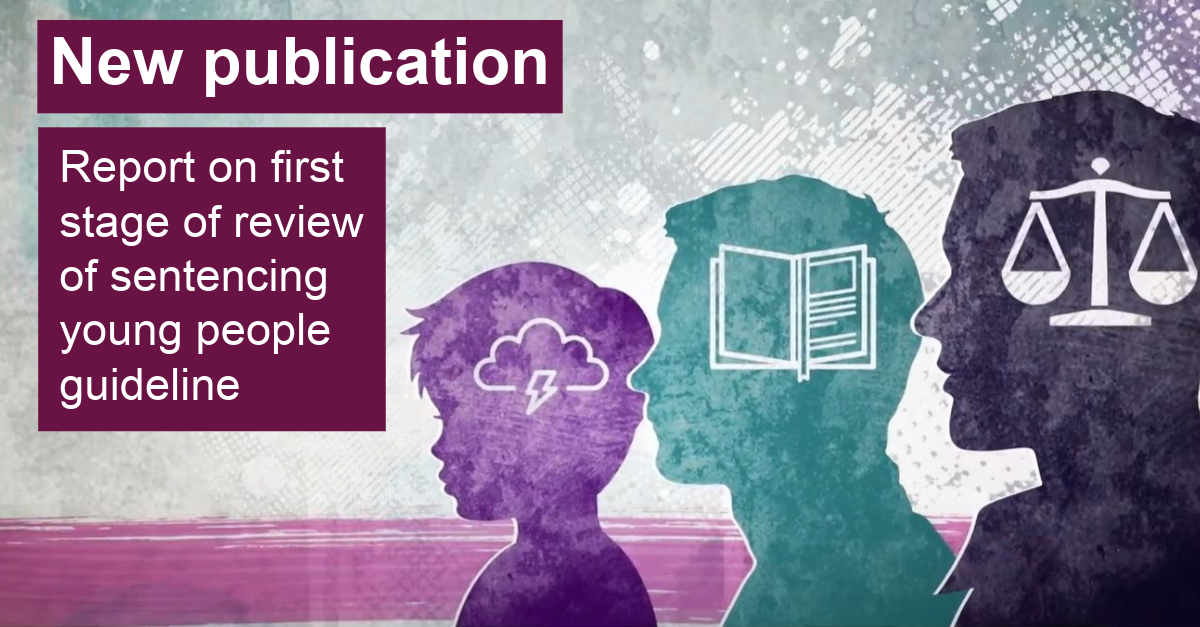Council publishes report on first stage of review of sentencing young people guideline

The Council has today published a report on the routine review of the operation of the “Sentencing young people” guideline during its first year in force. The guideline, which was approved by the High Court in November 2021, has applied since 26 January 2022 to the sentencing of young people aged 24 or under when convicted of an offence.
The Council has a statutory duty to review its guidelines from time to time and takes a staged approach to this, involving reviews after both one year and three years in force. For the one-year review of the “Sentencing young people” guideline, the Council analysed sentencing data for the period 26 January 2022 to 25 January 2023, the first year of the guideline’s operation, and the five preceding years. In addition to data on offenders aged 24 and under, the review also includes analysis of data on offenders aged 25 and over for an indicative comparison.
By its nature, the review covers a relatively narrow timeframe, within which certain key sentencing data – for example, on review hearings for community sentences – were accordingly not available, meaning it provides a snapshot rather than a fully detailed picture. It also highlights that other factors, such as criminal justice measures to respond to the impact of the Covid-19 pandemic, as well as a change in the law in July 2019 which extended the presumption against short sentences to 12 months or less, are difficult to separate from any potential changes that could be attributed to the guideline.
Commenting on publication of the review, Lady Dorrian, Lord Justice Clerk and Chair of the Council, said: “The Council is pleased to publish this research review, which is the first in its programme of routine reviews of sentencing guidelines. We hope that it will help to increase understanding of the sentencing of young people by setting out initial evidence of how the guideline has been operating in practice. However, it is only the first stage in our review process. Now that the guideline has been in effect for a sufficient period of time to allow more in-depth examination of its potential impacts we will, in line with our methodology, begin a wider-ranging review of the evidence available. This will involve both qualitative and quantitative research, exploring the guideline’s operation between 26 January 2023 and 25 January 2024 and the same period in 2024 to 2025, in addition to its first year. The one-year review provides a solid evidence base for that.”
Among the review’s key findings are that:
- there is no sign that the guideline had any unintended consequences in its first year or that it has affected court volumes or the pattern of offending by young people
- custody rates for offenders aged both under 25 and 25 and over fell in 2022-23 but the drop was greater for the 21 to 24 age group – a causal link with the guideline cannot be established on statistics alone and other factors, such as Covid-19 and the presumption against short sentences of 12 months or less, are likely to have played a part in this
- the evidence is inconclusive as to whether the guideline has affected the rate of community payback order disposals for young people.
The review also found that during the guideline’s first year in operation and in each of the preceding five years:
- custody rates were higher in percentage terms for offenders aged 25 and over than for under 25s
- the average length of custodial sentences was higher for offenders aged 25 and over than for under 25s as a whole
- the rates of community payback orders, restriction of liberty orders, admonitions, and absolute discharges were lower, and the rates of fines were higher, for offenders aged 25 and over than for under 25s.
Lady Dorrian continued: “The Council anticipated that the guideline would have the greatest effect on sentencing decisions for offenders aged 21 to 24, leading to a greater emphasis on rehabilitation and a possible change to sentencing practice as a result. While there are some indications of this, there is also evidence that courts were in fact already approaching the sentencing of those under 25 differently from those aged 25 and over during the five years before the guideline’s introduction. In order to gain a more detailed understanding of how the guideline is being applied in practice, we need a larger dataset, as well as to carry out research with sentencers and others.”
The research review can be read here.
Further information about the guideline is available here.
Notes
- Under section 3(6)(a) of the Criminal Justice and Licensing (Scotland) Act 2010, the Council must “from time to time review any sentencing guidelines published by it”.
- In December 2022, the Council agreed on a methodology for the monitoring and review of offence and offender specific guidelines. This is published on the Council’s website: https://www.scottishsentencingcouncil.org.uk/sentencing-guidelines/methodology/stage-8.
- The majority of the data included in the review is for all disposals, with each disposal considered separately. It should be noted that multiple disposals may be recorded for any given individual. This means that the data on disposals and disposal rates do not equate to the number of offenders sentenced. ‘Custody rates’ refers to the rates of custodial disposals in any given year.
- The average lengths of custodial sentences provided in the review do not include extended sentences, life sentences, and orders for lifelong restriction.
- Alongside the three-year review of the sentencing young people guideline, the Council will be undertaking a one-year review of the operation of its guideline on statutory offences of causing death by driving during its first year in effect (16 January 2024 to 15 January 2025).

